Уникальные климатические условия и расположение Австралии определили и оригинальность ее флоры и фауны. Данную презентацию составили ученики 10 класса и они как раз доказали разновидность, уникальность и красоту растительного мира Австралии. Также в данной презентации воспитывается бережное отношение к природе и стремление сохранить красоту Австралии
P
resentation
MADE BY PUPILS OF FORM 10
«A»:
BATYUSHKOVA HELEN
VALEREVNA,
SUPERVISOR ENGLISH
LANGUAGE
ALBINA GATAULLINA
GARIPOVNA
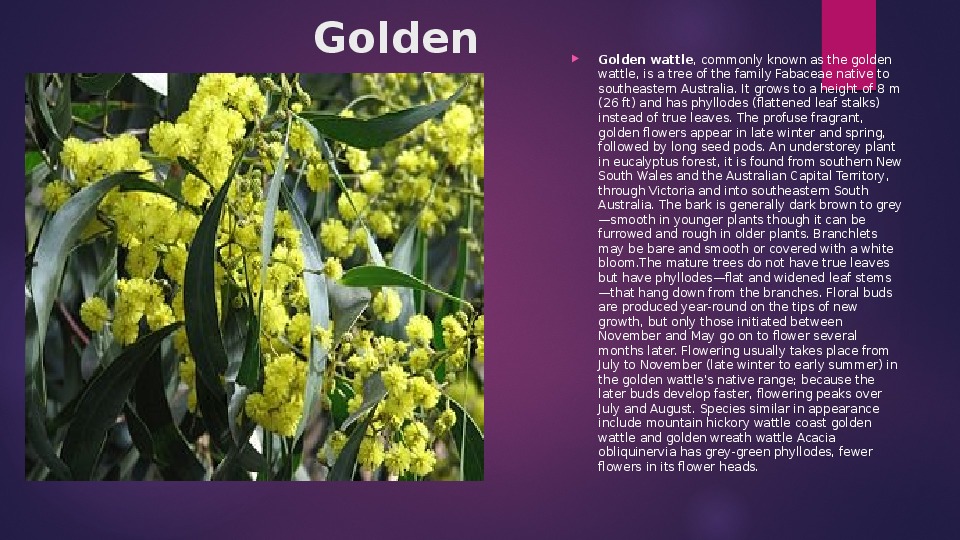
Golden
wattle
Golden wattle, commonly known as the golden
wattle, is a tree of the family Fabaceae native to
southeastern Australia. It grows to a height of 8 m
(26 ft) and has phyllodes (flattened leaf stalks)
instead of true leaves. The profuse fragrant,
golden flowers appear in late winter and spring,
followed by long seed pods. An understorey plant
in eucalyptus forest, it is found from southern New
South Wales and the Australian Capital Territory,
through Victoria and into southeastern South
Australia. The bark is generally dark brown to grey
—smooth in younger plants though it can be
furrowed and rough in older plants. Branchlets
may be bare and smooth or covered with a white
bloom.The mature trees do not have true leaves
but have phyllodes—flat and widened leaf stems
—that hang down from the branches. Floral buds
are produced year-round on the tips of new
growth, but only those initiated between
November and May go on to flower several
months later. Flowering usually takes place from
July to November (late winter to early summer) in
the golden wattle's native range; because the
later buds develop faster, flowering peaks over
July and August. Species similar in appearance
include mountain hickory wattle coast golden
wattle and golden wreath wattle Acacia
obliquinervia has grey-green phyllodes, fewer
flowers in its flower heads.
Wahlenbergia
gloriosa
Wahlenbergia gloriosa, commonly known as
Royal Bluebell or Royal Bluebird, is an
Australian wildflower from the
Campanulaceae family. It grows in high
rainfall areas in the Australian Alps, in
environs ranging from shady roadside
cuttings on Mount Hotham to full sun
herbfields on the main range.W. gloriosa has
small dark green leaves in rosettes, to 2 cm.
The flowers are a deep blue/purple colour,
and are very eyecatching. The colour is not
reproducible on a computer screen or normal
film (being a shade of violet, rather than
purple). It grows as a suckering herb. The
flower is the floral emblem of the Australian
Capital Territory.Wahlenbergias are generally
easily propagated by division or root cutting.
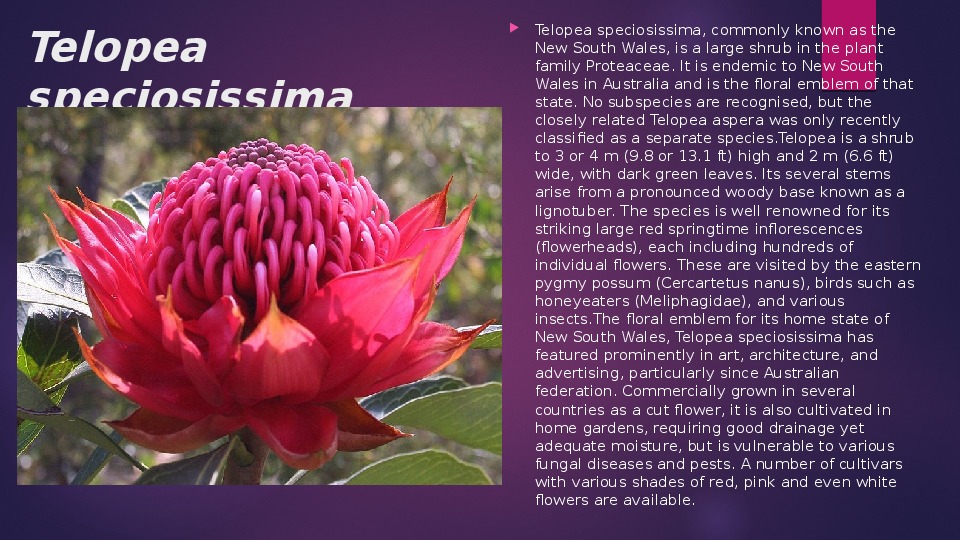
Telopea
speciosissima
Telopea speciosissima, commonly known as the
New South Wales, is a large shrub in the plant
family Proteaceae. It is endemic to New South
Wales in Australia and is the floral emblem of that
state. No subspecies are recognised, but the
closely related Telopea aspera was only recently
classified as a separate species.Telopea is a shrub
to 3 or 4 m (9.8 or 13.1 ft) high and 2 m (6.6 ft)
wide, with dark green leaves. Its several stems
arise from a pronounced woody base known as a
lignotuber. The species is well renowned for its
striking large red springtime inflorescences
(flowerheads), each including hundreds of
individual flowers. These are visited by the eastern
pygmy possum (Cercartetus nanus), birds such as
honeyeaters (Meliphagidae), and various
insects.The floral emblem for its home state of
New South Wales, Telopea speciosissima has
featured prominently in art, architecture, and
advertising, particularly since Australian
federation. Commercially grown in several
countries as a cut flower, it is also cultivated in
home gardens, requiring good drainage yet
adequate moisture, but is vulnerable to various
fungal diseases and pests. A number of cultivars
with various shades of red, pink and even white
flowers are available.
Sturt's Desert
Rose
Sturt's Desert Rose (Gossypium sturtianum)
is a woody shrub, closely related to cultivated
cotton, found in most mainland states of
Australia and the Northern Territory. It is also
known as the Darling River Rose, Cotton
Rosebush and Australian Cotton.The plant
has a life span of about 10 years, growing
from 1–2 m tall and 1–2 m wide. The colour of
the petals can range from pale pink to dark
purple to maroon. The five petals are
arranged in a whorl and have a dark red
centre. They can be seen for most of the year
but peak in late winter. They are up to 12 cm
in diameter. The leaves are different shades
of green, round and strongly scented when
crushed.
Cooktown Orchid
The Cooktown Orchid has been the floral
emblem of Queensland since 19 November 1959.
It was first described in 1880 as Dendrobium
phalaenopsis, then included in Dendrobium
bigibbum,More recently, the D. bigibbum
complex has been separated into the genus
Vappodes.[3] The new name of Vappodes
phalaenopsis has now been accepted by the
World Checklist of Monocotyledons, .The Two-
humped Dendrobium (Dendrobium bigibbum) is
a species of orchid. It is native to New Guinea
and to the Cape York Peninsula of Queensland. It
is also reportedly naturalized in Hawaii.

Sturt's Desert Pea
Swainsona formosa, Sturt's Desert Pea, is
an Australian plant in the genus Swainsona,
named after English botanist Isaac
Swainson, famous for its distinctive blood-
red leaf-like flowers, each with a bulbous
black centre, or "boss". It is one of
Australia's best known wildflowers. It is
native to the arid regions of central and
north-western Australia, and its range
extends into all mainland Australian states
with the exception of Victoria. Specimens of
Sturt's desert pea were first collected by
William Dampier who recorded his first
sighting on 22 August 1699. These
specimens are today in the Fielding-Druce
Herbarium at Oxford University in England.
The common name honours Charles Sturt,
who recorded seeing large quantities of the
flowers while exploring central Australia in
1844; the second version of the scientific
name honours the naturalist Isaac
Swainson, and the third (rejected) version of
the scientific name was intended to honour
the explorer William Dampier.
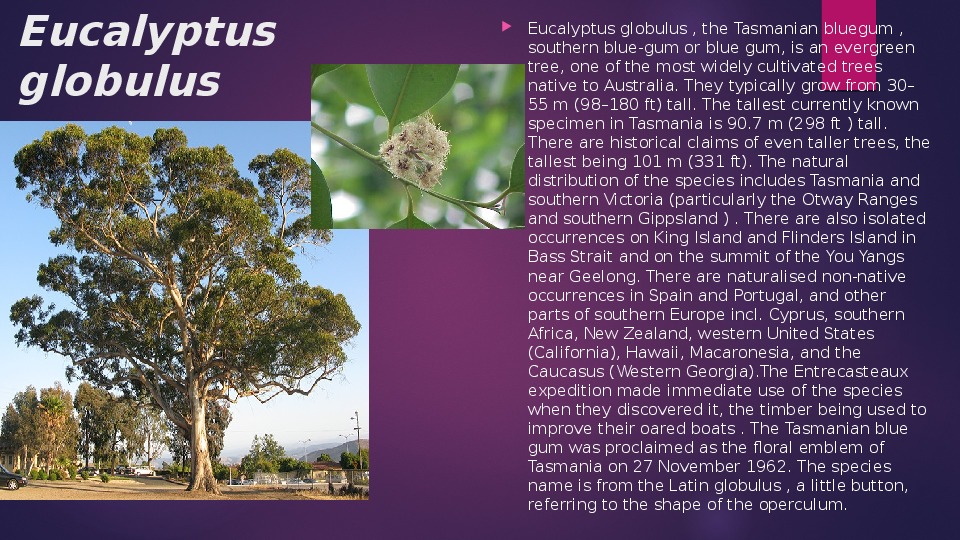
Eucalyptus
globulus
Eucalyptus globulus , the Tasmanian bluegum ,
southern blue-gum or blue gum, is an evergreen
tree, one of the most widely cultivated trees
native to Australia. They typically grow from 30–
55 m (98–180 ft) tall. The tallest currently known
specimen in Tasmania is 90.7 m (298 ft ) tall.
There are historical claims of even taller trees, the
tallest being 101 m (331 ft). The natural
distribution of the species includes Tasmania and
southern Victoria (particularly the Otway Ranges
and southern Gippsland ) . There are also isolated
occurrences on King Island and Flinders Island in
Bass Strait and on the summit of the You Yangs
near Geelong. There are naturalised non-native
occurrences in Spain and Portugal, and other
parts of southern Europe incl. Cyprus, southern
Africa, New Zealand, western United States
(California), Hawaii, Macaronesia, and the
Caucasus (Western Georgia).The Entrecasteaux
expedition made immediate use of the species
when they discovered it, the timber being used to
improve their oared boats . The Tasmanian blue
gum was proclaimed as the floral emblem of
Tasmania on 27 November 1962. The species
name is from the Latin globulus , a little button,
referring to the shape of the operculum.
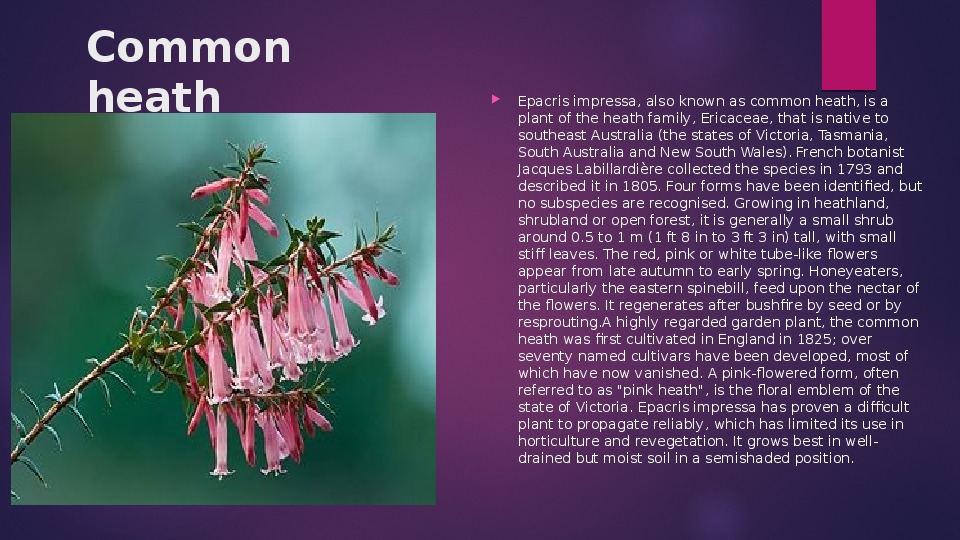
Common
heath
Epacris impressa, also known as common heath, is a
plant of the heath family, Ericaceae, that is native to
southeast Australia (the states of Victoria, Tasmania,
South Australia and New South Wales). French botanist
Jacques Labillardière collected the species in 1793 and
described it in 1805. Four forms have been identified, but
no subspecies are recognised. Growing in heathland,
shrubland or open forest, it is generally a small shrub
around 0.5 to 1 m (1 ft 8 in to 3 ft 3 in) tall, with small
stiff leaves. The red, pink or white tube-like flowers
appear from late autumn to early spring. Honeyeaters,
particularly the eastern spinebill, feed upon the nectar of
the flowers. It regenerates after bushfire by seed or by
resprouting.A highly regarded garden plant, the common
heath was first cultivated in England in 1825; over
seventy named cultivars have been developed, most of
which have now vanished. A pink-flowered form, often
referred to as "pink heath", is the floral emblem of the
state of Victoria. Epacris impressa has proven a difficult
plant to propagate reliably, which has limited its use in
horticulture and revegetation. It grows best in well-
drained but moist soil in a semishaded position.
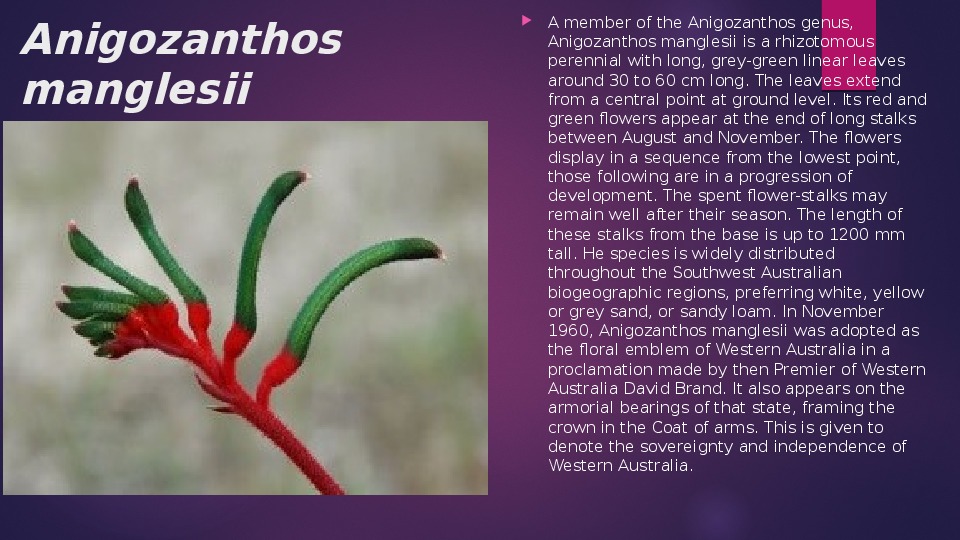
Anigozanthos
manglesii
A member of the Anigozanthos genus,
Anigozanthos manglesii is a rhizotomous
perennial with long, grey-green linear leaves
around 30 to 60 cm long. The leaves extend
from a central point at ground level. Its red and
green flowers appear at the end of long stalks
between August and November. The flowers
display in a sequence from the lowest point,
those following are in a progression of
development. The spent flower-stalks may
remain well after their season. The length of
these stalks from the base is up to 1200 mm
tall. He species is widely distributed
throughout the Southwest Australian
biogeographic regions, preferring white, yellow
or grey sand, or sandy loam. In November
1960, Anigozanthos manglesii was adopted as
the floral emblem of Western Australia in a
proclamation made by then Premier of Western
Australia David Brand. It also appears on the
armorial bearings of that state, framing the
crown in the Coat of arms. This is given to
denote the sovereignty and independence of
Western Australia.
Lesser Flannel
Flower
Actinotus minor, the Lesser Flannel Flower
is a common plant growing in heathland in
moist areas not far from Sydney, Australia.
A small shrub, 15 to 50 cm tall, with white
flowers, similar to the related and more
famous Flannel Flower.Leaves are small
and pointed, divided in threes. 6 to 8 mm
long, white below the leaf. The leaf stem is
up to 12 mm long. Stems are long and
slender. Flowers are 12 mm wide, without
petals, but they look similar to daisies, with
the bracts appearing as petals. Flowering
can occur at any time of year, though
mostly in summer. Flower stems are
between 4 and 12 cm long. The hairy egg-
shaped fruit capsule is 2 to 3 mm long.This
plant first appeared in scientific literature
in the year 1830, authored by the
prominent Swiss botanist, Augustin
Pyramus de Candolle.
Gymea Lily
Australian native perennial lily with
rosettes of large sword-shaped, light
green leaves over 1m (3′) long . In spring
and summer, deep blood-red flowers
appear on the end of tall stems or scapes
up to 6m (20′) tall. Flowers are followed
by woody capsules which split open when
ripe, releasing flat, slightly winged seeds.
Plants grown from seed take 6-7 years to
flower. oryanthes excelsa grows best in
Adelaide, Sydney, Melbourne, Perth,
Brisbane, and inland zones. It will also
grow in cooler areas but the flower spikes
are sometimes damaged by frosts.
